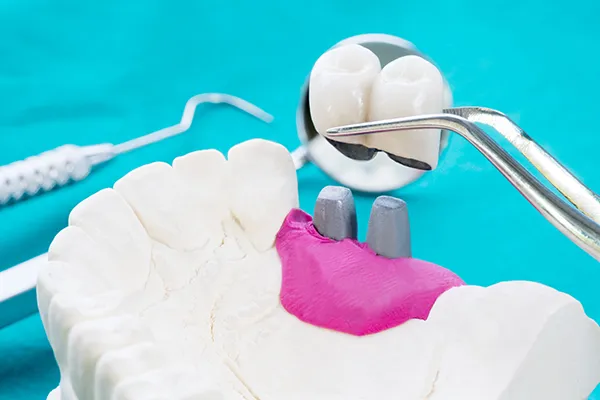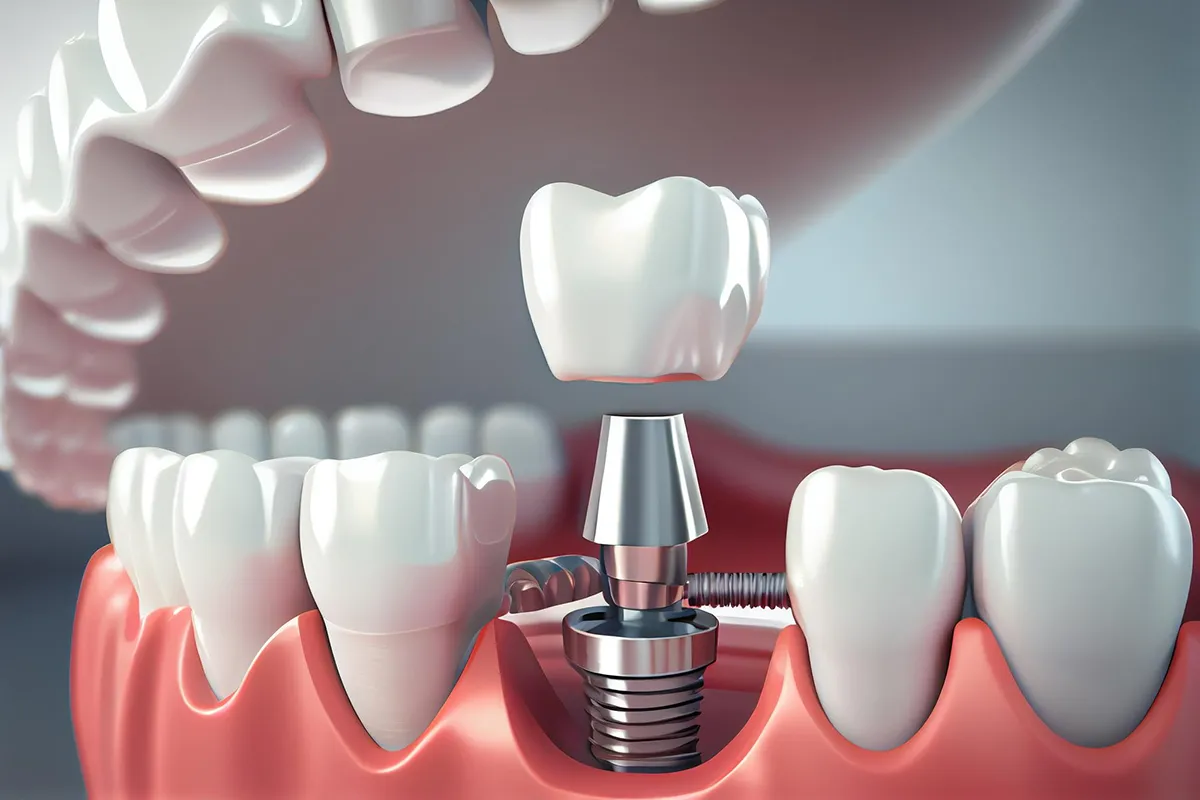Dental bridge and implant options have become popular among individuals seeking a restoration solution for missing teeth. Whether due to tooth loss caused by decay, injury, or other dental issues, understanding the differences between dental bridges and implants is crucial in making an informed decision about the best treatment for your unique situation.
Bridges and Implants: Restoring Smiles with Confidence
Bridges, as the name suggests, is the gap created by one or more missing teeth. They consist of artificial teeth held in place by dental crowns connected to adjacent natural teeth or implants. Bridges provide several advantages, including:
- Restored Functionality: Dental bridges allow you to chew and speak correctly, restoring your ability to enjoy a wide range of foods and communicate without hesitation.
- Improved Appearance: Bridges fill the gaps left by missing teeth, enhancing your smile and facial aesthetics.
- Affordable Option: Compared to implants, bridges are often a more cost-effective solution in the short term. They require a less invasive procedure and typically have a lower upfront cost.
On the other hand, dental implants offer a more advanced and independent approach to tooth replacement. Implants require a surgical procedure where titanium posts are placed into the jawbone, serving as synthetic tooth roots. Dental implants have the following key benefits:
- Enhanced Stability: Implants fuse with the jawbone through osseointegration, providing a sturdy and permanent foundation for replacement teeth. This stability allows for confident biting and chewing.
- Longevity: Dental implants have the potential to last a lifetime with the proper care. They are highly durable and resistant to decay and deterioration.
- Bone Preservation: Implants stimulate the jawbone, preventing bone loss that commonly occurs with tooth loss. It helps maintain facial structure and prevents adjacent teeth from shifting.
- Natural Look and Feel: Implants offer a natural-looking and seamless result. The replacement teeth match the natural teeth, providing a lifelike appearance.
Key Differences between Bridges and Implants
- Support System:
Dental bridges rely on support from neighboring teeth or implants. They are anchored by dental crowns attached to the adjacent teeth, creating a bridge to hold the artificial teeth in place.
Dental implants stand independently by fusing with the jawbone. They are a strong foundation for replacement teeth, acting as artificial roots.
- Aesthetics:
Bridges may not achieve an exact match with natural teeth, while implants offer a more precise and natural-looking result. Bridges provide a functional solution, but their aesthetics may not match natural teeth perfectly. However, they still resemble your existing teeth closely.
Implants offer a more natural look. The replacement teeth match your natural teeth’ color, shape, and alignment, resulting in a seamless and natural appearance.
- Cost:
Dental bridges are often more cost-effective initially since they involve a more straightforward procedure and do not require surgery. However, it’s essential to consider potential future bridge replacement or maintenance costs.
While dental implants are costly due to the surgical procedure and the materials involved, they offer long-term cost-effectiveness. Implants have the potential to last a lifetime with proper care, eliminating the need for frequent replacements or repairs.
- Procedure:
Bridges involve a quick procedure compared to the surgical process of implants. Placing dental bridges requires minimal invasive procedures, such as preparing the adjacent teeth for crowns and attaching the bridge to them.

Dental professionals surgically insert the titanium posts into the jawbone during the surgical procedure for implants. It is followed by a healing period before attaching the replacement teeth.
- Surrounding Tissue Preservation:
Over time, bridges can exert pressure on the gums and underlying bone, potentially leading to tissue recession. It may cause a change in the appearance of the gum line and compromise the overall aesthetics.
Implants help preserve the natural contours of the gums and bone. They integrate with the jawbone, stimulating it just like natural tooth roots. It helps maintain the surrounding tissue’s health and aesthetics, providing a more natural and pleasing smile.
- Bone Preservation:
Implants support bone preservation, while bridges do not provide the same stimulation level. The jawbone may experience bone loss when bridges are used without replacing the missing tooth roots, as they do not stimulate the jawbone.
Implants stimulate the jawbone, promoting bone growth and preventing bone loss. They help maintain the integrity of the jawbone and facial structure.
“Dental implants offer an enduring solution for replacing missing teeth, as they function and feel like natural teeth. Bridges rely on adjacent natural teeth or implants for support, which may require alteration of healthy teeth”.
- Maintenance and Oral Hygiene:
Special attention is needed to clean under the bridge, as it can trap food particles and plaque, increasing the risk of decay and gum disease. Using floss threaders or interdental brushes can help maintain oral hygiene.
Regular brushing, flossing, and dental check-ups are essential to keep the implant and surrounding gums healthy. Implants require no extra steps or tools required beyond standard oral hygiene practices.
- Suitability for Multiple Missing Teeth:
Dental bridges are suitable for replacing one or a few consecutive missing teeth. They rely on the support of adjacent teeth or implants. However, there may be better solutions than bridges regarding extensive tooth loss.
Dental implants offer versatility; they can replace a missing tooth or support implant-supported bridges or dentures when multiple teeth are missing. They provide a stable foundation and can accommodate various tooth replacement needs.
- Durability:
Bridges may need to be replaced after a certain period, while implants can last a lifetime. Bridges typically work for around 10 to 15 years and may require replacement over time due to wear and tear.
Implants have the potential to last a lifetime with proper care and maintenance, as they are highly durable and resistant to decay.
Dental Implants vs. Bridges: Which One is Right for You?
Each option has advantages and considerations, making assessing your needs and preferences crucial. Here, we explore essential factors to help you determine which choice is right for you.
Oral Health and Bone Density:
- Implants require a healthy jawbone to provide a stable foundation. Sufficient bone density is necessary to support the implant.
- Bridges can be suitable if healthy adjacent teeth support the bridge structure. However, the teeth supporting the bridge may require alteration, impacting their long-term health.

Number of Missing Teeth:
- Implants are suitable for replacing a single missing tooth, multiple missing teeth in different areas, or even full arches with implant-supported dentures.
- Bridges are ideal for replacing one or a few consecutive missing teeth. They may not be the best solution for extensive tooth loss.
Aesthetics and Natural Look:
- Implants offer the most natural-looking and seamless result. The replacement tooth is custom-made to match your existing teeth’ color, shape, and alignment, providing an aesthetically pleasing outcome.
- While bridges can restore functionality, their appearance may not perfectly mimic natural teeth. They may not achieve an exact match of your natural teeth.
Longevity and Durability:
- Implants have the potential to last a lifetime with proper care and maintenance. They are highly durable and resistant to decay, making them a long-term investment.
- On average, bridges have a lifespan of approximately 10 to 15 years before they may require replacement due to wear and tear. Regular check-ups and maintenance are necessary to ensure their longevity.
Cost Considerations:
- Implants generally have a higher initial cost compared to bridges. However, considering their longevity and long-term benefits, they may offer greater cost-effectiveness over time.
- Bridges are often more affordable upfront but may require future replacements or repairs, which can incur additional costs.
Consulting with a dental professional is crucial to evaluate your specific situation. He will assess your oral health, bone density, number of missing teeth, and other factors to help you make an informed decision.
Final Words:
Remember, both dental implants and bridges have successfully restored countless smiles. The ultimate goal is to choose the option that best suits your unique circumstances, ensuring a comfortable, functional, and aesthetically pleasing outcome.
Contact your Pinole dentist, Azadeh Hosseini, DDS, or Ghazal Hosseini, DDS, at Top Pinole Dental to learn more about the Dental Bridge Vs. Implant.
Resource:
The Dental Bridge Procedure: Step-by-Step Guide
*This media/content or any other on this website does not prescribe, recommend, or prevent any treatment or procedure. Therefore, we highly recommend that you get the advice of a qualified dentist or other medical practitioners regarding your specific dental condition.*
1500 Tara Hills Dr., Suite 104A, Pinole, CA 94564
Monday – Saturday 8:00 AM to 5:00 PM
